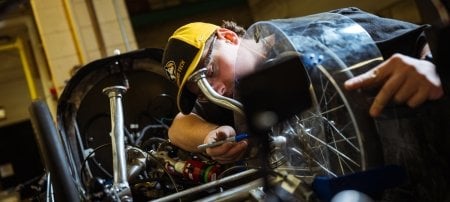New Grad Course Leads to Better Writing for Mechanical Engineering Undergrads

For many engineering students, writing is a chore at best. While there are some who excel at the craft, many panic at the very prospect of putting words on paper.
Yet, from their sophomore year until graduation, that’s exactly what mechanical engineering students must do to succeed in a series of three laboratory classes. To complicate matters, their reports are graded by graduate students, including many foreign nationals for whom English is a second language.
Michigan Technological University's Nancy Barr thought there might be a way to improve the process. “I’ve been the department’s technical communications advisor for nearly five years, and as I began looking at our curriculum, I started with easy stuff: Senior Design report writing and presentation skills,” she said. But before she worked with students in Senior Design, they had already been writing reports for two years, and Barr wanted to reach them during that critical time. The best way, she reasoned, was through their lab instructors.
“The graduate teaching assistants were required to evaluate the reports, but they didn’t have any real training, and their guidance was inconsistent,” she said. “I thought they would be a good place to start developing technical communications skills in our department.”
To address the problem, she began work on a series of training modules for teaching assistants that may be the only one of its kind in the nation. The modules are adapted from Writing Across the Curriculum faculty training sessions that teach evaluators how to provide effective feedback on writing, the key to improving student communication. In addition, in 2012, Barr met with faculty and course coordinators to develop a set of report guidelines that would meet the needs of all three engineering labs. That way, undergraduates would face similar expectations as they advanced through the mechanical engineering curriculum.
Next, she joined faculty and TAs in developing a grading rubric to build consistency from one lab to the next. “That was a really enjoyable experience,” Barr said. “It got faculty thinking about why students do lab reports and what we want them to learn.”
Finally, they incorporated their work into training sessions for the GTAs. “Most are nonnative English speakers, so asking them to evaluate native speakers’ writing can be a little touchy,” she said. So, the GTAs are taught to focus on how well their students have followed the report-writing guidelines and how to grade based on the rubric. The undergraduates are responsible for their own grammar and punctuation.
In the short course, GTAs discuss how to evaluate writing and “get their fears on the table,” Barr said. “We help them develop methods to address issues that might pop up. The biggest thing they face is just the volume of work. There are often 30 to 35 students in a section.”
The TAs’ guidelines go beyond red-pen editing; they are meant to provide helpful feedback, not a slap on the wrist. “It’s not about crossing things out that don’t make sense or writing question marks,” Barr said. “If TAs mark a section down, they need to explain why. The focus is on content: does the undergraduate present content in a logical way that engages the reader and includes all the important information? We also teach them a little about the concept of audience. That’s not something you hear much about in engineering, but all writing should be targeted to the appropriate audience. Employers want people who can communicate with a variety of people.”
Ranjeeth Naik, a PhD student in mechanical engineering, took the training when it was first offered, in fall 2012. “It was the first time I’d had such a class, and I would have been glad to have it before I started TA-ing,” he said. “Once you know the guidelines, the reports almost grade themselves, and it’s much easier for our students to improve. It’s an excellent class.”
Naik is not alone in his enthusiasm. Based on surveys of students and TAs at end of the spring 2013 semester, the new guidelines and rubrics “are overwhelmingly appreciated,” Barr said. “The undergraduates felt it saved them time and that they learned something. It’s too soon to tell if it actually improves their writing, but in spring 2015, we’ll compare the Senior Design reports to reports from fall 2012, because those students wouldn’t have had TAs who had that training. We’ll see if we can see any improvement.”
Associate Professor Ibrahim Miskioglu, who coordinates the solid mechanics portion of MEEM 3000 Mechanical Engineering Lab, gave Barr high marks. “She’s helping the TAs a lot--and helping us a lot--in that regard,” he said. “I appreciate that she is not just creating this methodology on her own. She asks for input from everybody, and the quality of her work reflects that. I have nothing but praise for what she’s doing.”
William Predebon, chair of the Department of Mechanical Engineering–Engineering Mechanics, is also enthusiastic in his support of the expanded writing program. “Since Nancy has been working in Senior Design, our External Advisory Board has noticed a marked improvement in the students’ reports,” he said. “And she’s been so successful working with GTAs in our labs, that we’re talking about doing this for all our graduate students, to improve their communications skills. They will all be writing dissertations and be presenting nationally and internationally, and those skills will not only help them find a position, they will reflect well on Michigan Tech.”
Michigan Technological University is a public research university founded in 1885 in Houghton, Michigan, and is home to more than 7,000 students from 55 countries around the world. Consistently ranked among the best universities in the country for return on investment, Michigan’s flagship technological university offers more than 120 undergraduate and graduate degree programs in science and technology, engineering, computing, forestry, business and economics, health professions, humanities, mathematics, social sciences, and the arts. The rural campus is situated just miles from Lake Superior in Michigan's Upper Peninsula, offering year-round opportunities for outdoor adventure.




Comments